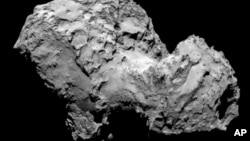A team of scientists identified on Monday the point on the surface of a comet, known as “Site J,” where they aim to land a probe in what would be a historic breakthrough for their decade-long project.
The probe or lander will be dispatched from the Rosetta spacecraft, which was launched by the European Space Agency (ESA) in 2004 and has been tracking comet 67P/Churyumov-Gerasimenko on its trip around the sun.
Scientists hope data the lander gathers on the surface of the comet will allow them to peek into a kind of astronomical time capsule that will offer clues about what the world looked like when our solar system was born.
The lander will drill more than 20 cm into the comet's surface to collect samples for analysis. By studying the comet's dust and gas, scientists hope to learn more about the role comets played in the development of Earth and the other planets in our solar system.
Timing is a vital part of the process. They need to wait until the comet has got close enough to the sun for the probe's solar panels to work, but must also land it before the increasing heat causes activity levels of the comet to rise so much that it would endanger a safe landing.
They have determined that a landing window will open up on Nov. 11, when the comet will be 450 million km from the sun.
Rosetta caught up with the comet in August and since then has been relaying pictures of the mass and its surface back to earth. While it is now within 30 km of the comet, the pictures are not of a high enough resolution to allow for detailed inspection of its surface.
“We don't know what the terrain looks like in detail,” Paolo Ferri, head of mission operations at ESA, told Reuters ahead of the landing site decision. “But there's certainly no nice landing strip. We have to rush into this with the minimum amount of information.”
Precision Landing
Known as Philae, the three-legged lander must not descend too slowly or too quickly, its trajectory has to take into account the rotation of the comet, there has to be enough battery power left after landing to deploy its instruments, and detaching it from Rosetta has to be perfectly timed.
Once the box-shaped 100 kg probe has landed, the team will concentrate on setting up Philae's solar panels so it can start relaying data to Rosetta, which will continue to orbit the comet until at least of the end of 2015 and possibly longer if more funding can found.
An initial 10 landing sites had already been whittled down to five and a team of engineers and scientists met over the weekend to select one preferred site and one back-up.
The target Site J is on the “head” of the comet, an irregular body that is just over 4 km across at its widest point, the ESA said in a statement.
It said the chosen site offers “unique scientific potential, with hints of activity nearby, and minimum risk to the lander compared to the other candidate sites”.
A backup, Site C, is located on the “body” of the comet.
Landing a probe is one of several historical firsts performed by the mission, including the first time a spacecraft orbits a comet rather than just whizzing past to snap pictures.
“Everything up until now has gone much better than we thought and hopefully it will continue,” Ferri said.









